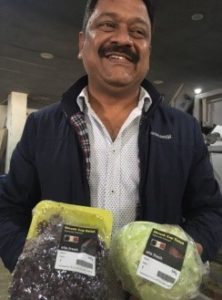4th April 2017 New Delhi, India
India’s cool revolution
The Birmingham Energy Institute (BEI) brought out a twelve member UK delegation related to cold chain system, comprising of experts from BEI and companies to India in the week of 27 February 2017. Professor Toby Peters from BEI led this UK delegation. The aim of the visit was to forge new academic and industry collaborations, build capacity and explore market suitable technology deployment, including establishment of live test beds for demonstration. The visit began with a study tour in Chandigarh and ended with a workshop in New Delhi. The study tour programme as supported by Department for International Trade (DIT) comprised of visit to vegetable markets and cold storage units in Haryana and Punjab. Science and Innovation Network (SIN) India helped with organisation of the workshop with support from the Indian National Center for Cold Chain Development. This activity was well aligned with the previous work done by SIN on food processing technologies.
Agriculture is the backbone of the Indian economy, employing almost half its workforce. The sector has been transformed since independence in 1947 through the ‘Green Revolution’, which staved off famine by dramatically increasing crop yields, and the ‘White Revolution’, which turned India into the world’s largest milk producer. Yet most of the country’s farmers work plots of less than 2 acres, and most remain trapped in the cycle of poverty.
To reach its full potential, Indian agriculture urgently needs a third revolution: the cool, revolution to build a sustainable cold chain connecting farms to cities, and allow small farmers to develop entrepreneurial agri-businesses serving the growing urban middle class. This new clean cold chain will conserve huge amounts of food that currently go to waste, leapfrog the old polluting technologies that dominate in the developed countries, and help achieve Prime Minister Modi’s target of doubling farmers’ incomes by 2022.
In a speech last year, Prime Minister Modi, declared a target of doubling Indian farmers’ income by 2022 and a 7-point plan to achieve it. One of the plan’s key measures is to develop ‘cold chains’ – an integrated network of refrigerated buildings and vehicles to transport produce from farm to metro consumption centre quickly and in good condition.
India’s cold chain capacity is minimal, and as a result, it’s estimated that for some crops more than 40% of the harvest rots and has to be thrown away before reaching any consumer. This represents not only a huge waste of food – with serious consequences for agricultural resources and carbon emissions – but also a major loss of income and opportunity for Indian farmers.
In February this year, the University of Birmingham led study tour of Punjab and Haryana states, India’s biggest agricultural producers, and held a two-day workshop in Delhi. The trip was organised with the help of the SIN and DIT from the British High Commission, the Horticulture Departments of Haryana and Punjab, and India’s National Center for Cold-chain Development (NCCD).

The workshop was attended by almost 100 Indian and British delegates, comprising farmers, technologists, academics and financial experts, and was addressed by India’s Secretary from the Indian Ministry of Agriculture & Farmers’ Welfare, S.K. Pattanayak. Through two days of intensive debate we developed a strong case for collaboration between Indian and British governments to accelerate the deployment of clean cold chains in India.
 During our tour we came across some inspiring examples of what India’s farmers are starting to achieve by investing in cold chains. We visited Seema Gulati and Amit Gupta’s farm at Karnal in Haryana.
During our tour we came across some inspiring examples of what India’s farmers are starting to achieve by investing in cold chains. We visited Seema Gulati and Amit Gupta’s farm at Karnal in Haryana.
For years the couple grew only staples such as potatoes, onions and carrots, and at harvest time – having no access to cold chains – they were forced to accept low prices for crops that were locally in glut. Then in 2014 they joined the NCCD, went on a cold chain training course, and invested in cold storage and refrigerated vehicles.
 Today the couple produce higher value perishable crops such as salad leaves and iceberg lettuce, sweetcorn, mushrooms and flowers under their own brand name – ‘Elle’ – which they sell into supermarkets in Delhi and Gurugram 250km away. Whereas one of their lettuce would fetch just Rs 3 at the farm gate, in the city malls it fetches Rs 100. Overall the farm’s revenue has tripled and its net income doubled, and they have just signed a deal to supply Walmart in Chandigarh. In future they hope to export their mushrooms.
Today the couple produce higher value perishable crops such as salad leaves and iceberg lettuce, sweetcorn, mushrooms and flowers under their own brand name – ‘Elle’ – which they sell into supermarkets in Delhi and Gurugram 250km away. Whereas one of their lettuce would fetch just Rs 3 at the farm gate, in the city malls it fetches Rs 100. Overall the farm’s revenue has tripled and its net income doubled, and they have just signed a deal to supply Walmart in Chandigarh. In future they hope to export their mushrooms.
But Seema and Amit are a rare example. There are many obstacles to farmers and others investing in cold chain. The NCCD estimates that India has just 15% of the refrigerated trucks it needs, and less than 1% of the pack-houses, the vital first stage of the cold chain that preconditions the produce for onward transport. This lack of infrastructure means just 4% of India’s food is moved through the cold chain compared to 70% in the UK.
The importance of cold chain is already well understood at the highest levels of India’s government. Cold chains don’t just reduce post-harvest food loss, but also allow farmers to earn more by maintaining the quality of their produce and selling it further afield – especially when this means they can reach more distant cities, and major centers of consumption.
The challenge is that conventional diesel-powered cooling of transport refrigeration units and pack-houses, for example, emits not only carbon dioxide (CO2) but also high levels of nitrogen oxides (NOx) and particulate matter (PM). To double farmers’ income by expanding the use of conventional, highly polluting cold chain technologies would simply mitigate one problem by significantly worsening another. Many clean cooling technologies are ready to go, but need to be demonstrated and promoted in India.
To reach its full potential, Indian agriculture urgently needs a third revolution: the ‘cool’ revolution to build a sustainable cold chain. It is hard to overstate the importance of this apparently narrow technical issue to achieving India’s environmental, economic and social goals. We hope our upcoming report, India’s third agricultural revolution, doubling farmers’ incomes through clean cold chain, will help establish an UK-India partnership to deliver India’s cool revolution.
